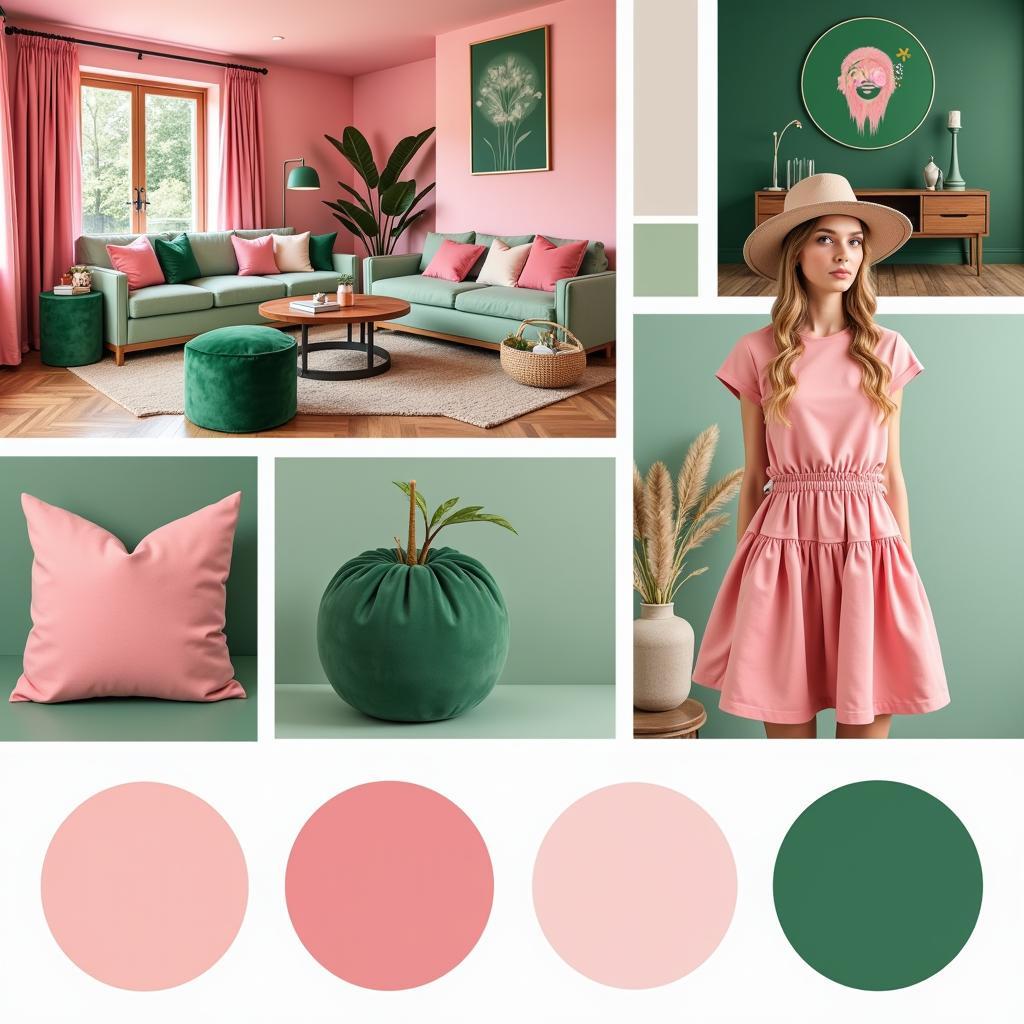Pink, a delicate and versatile hue, holds a special place in the world of color. But what color truly complements pink and elevates its inherent beauty? Understanding color theory, specifically complementary colors, is key to unlocking pink’s full potential in design, fashion, and even everyday life. We’ll explore the nuances of pink’s complementary color, delving into the various shades of pink and how they interact with their opposites on the color wheel.
Finding the perfect color combinations can transform a space. Knowing what is pink’s complementary color allows you to create visually appealing and balanced palettes. Whether you’re decorating your home, choosing an outfit, or designing a marketing campaign, understanding this fundamental principle of color theory is essential. You can find some great tips on coordinating outfits in our guide on what colors match blue pants.
Decoding Pink and its Complementary Counterpart
Pink, often perceived as a tint of red, sits between red and white on the color wheel. Its complementary color, therefore, lies on the opposite side of the spectrum. This leads us to green, specifically a shade of green that aligns with the intensity and undertones of the pink in question.
For a pure, vibrant pink, the complementary color is a similarly vibrant green. However, for softer, pastel pinks, a lighter, more muted green provides the perfect balance. The interplay between these two colors creates a dynamic visual contrast, enhancing the vibrancy of both.
Exploring Different Shades of Pink and Their Complements
Pink encompasses a wide range of shades, from the delicate blush of baby pink to the boldness of hot pink. Each shade has its own unique complementary green. For instance, a salmon pink leans towards orange and therefore pairs well with a teal green that has blue undertones. Conversely, a rose pink, with its purple undertones, finds harmony with a spring green containing hints of yellow.
Why Understanding Complementary Colors Matters
Using complementary colors creates a visually striking and harmonious effect. This principle is used extensively in various fields, including interior design, fashion, and graphic design. Knowing which colors complement each other allows you to create palettes that are both aesthetically pleasing and emotionally impactful.
For instance, in interior design, using pink and green can create a refreshing and vibrant space. In fashion, pairing a pink dress with green accessories can create a bold and stylish statement. Are you curious about makeup colors? Check out what color makeup should i wear for some helpful advice.
Creating Harmony with Pink and Green
While pink and green are naturally complementary, achieving the perfect balance requires careful consideration of the specific shades. Experimenting with different intensities and undertones is key to finding the ideal combination for your specific needs.
“Choosing the right shade of green to complement your chosen pink is crucial. A subtle shift in tone can dramatically impact the overall effect,” says renowned color consultant, Amelia Hues.
Practical Applications of Pink and Green
The combination of pink and green is versatile and can be applied in a myriad of ways. From creating a tranquil bedroom to designing an eye-catching logo, the possibilities are endless. Consider the mood and atmosphere you want to create and choose shades that align with your vision.
 Practical Applications of Pink and Green
Practical Applications of Pink and Green
“Don’t be afraid to experiment with different shades and intensities. The beauty of color lies in its ability to evoke emotions and create unique visual experiences,” adds Ms. Hues. You can even apply these color principles to festive decorations. Learn how to decorate christmas tree with colored lights for inspiration. For a different look, explore what color goes with tan shorts.
Conclusion
Understanding what is the complementary color of pink opens up a world of creative possibilities. By mastering the art of combining pink and green, you can create visually stunning and harmonious designs that leave a lasting impression. Whether you’re a professional designer or simply looking to enhance your personal style, embracing the power of complementary colors is a valuable skill.
FAQ
-
What is the exact complementary color of pink? The complementary color of pink depends on the specific shade of pink. Generally, it’s a shade of green.
-
Can I use any shade of green with pink? While all greens complement pink to some extent, certain shades create a more harmonious effect than others.
-
Where can I find inspiration for using pink and green? Nature is a great source of inspiration, as are fashion magazines and interior design websites.
-
Is it possible to overuse pink and green? Like any color combination, overuse can lead to visual fatigue. Balance is key.
-
What other colors can I combine with pink? Pink pairs well with a variety of colors, including white, black, gray, and even other shades of pink.
-
Are there any cultural connotations associated with pink and green? In some cultures, pink and green symbolize growth and renewal.
-
What are some common mistakes to avoid when using pink and green? Avoid using overly saturated shades without proper balance, as this can be overwhelming.
Need More Help with Color?
For all your color consultation needs, contact us!
Phone: 0373298888
Email: [email protected]
Address: 86 Cầu Giấy, Hà Nội.
We have a 24/7 customer service team ready to assist you. We also have other informative articles, like what is pink’s complementary color, to help you on your color journey.

